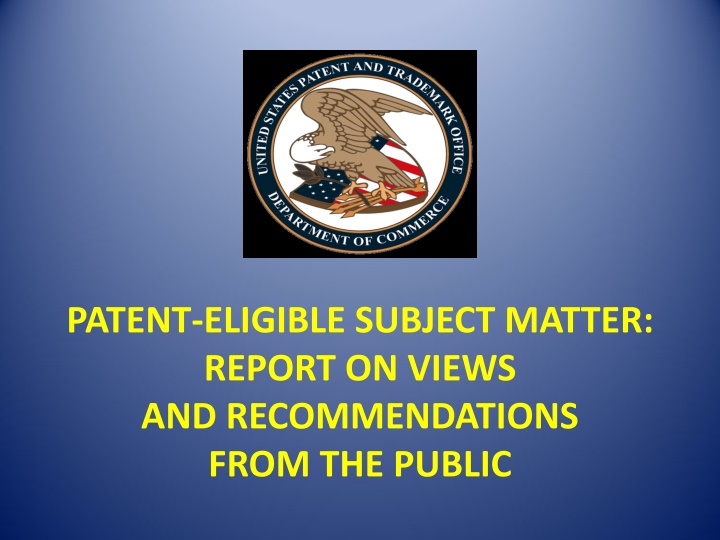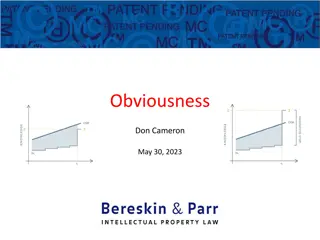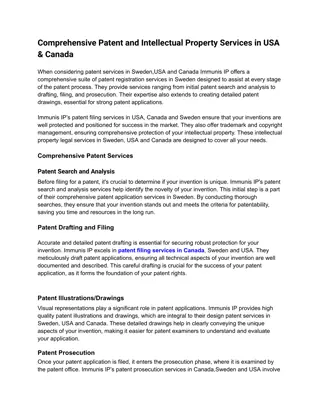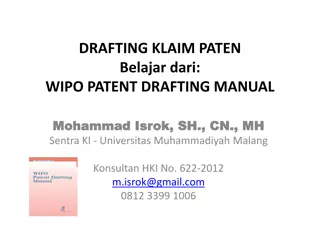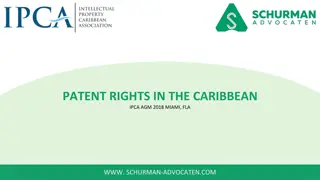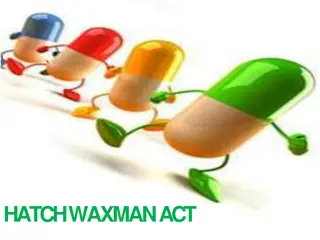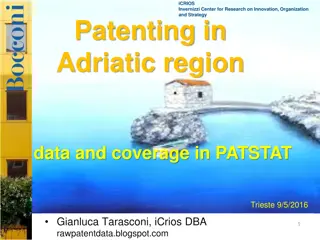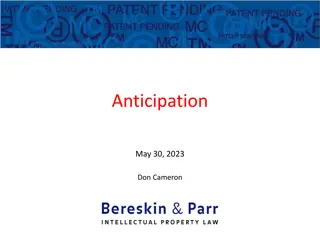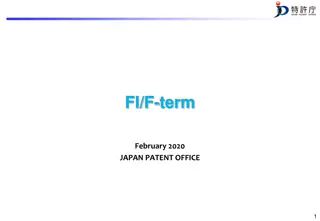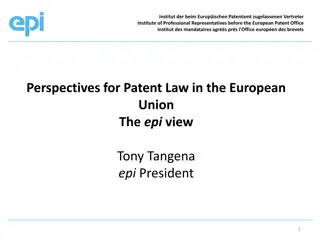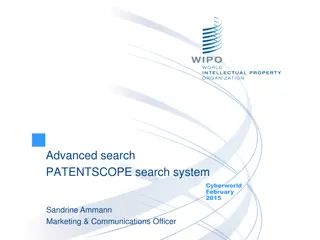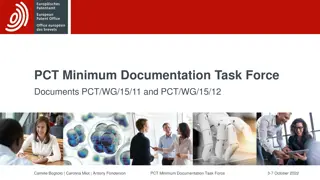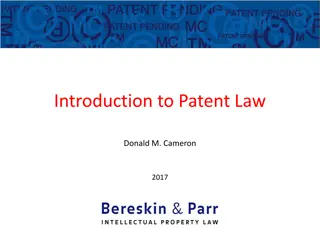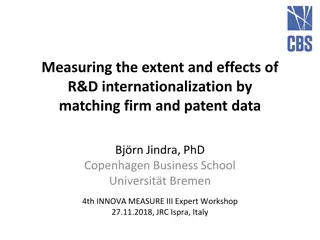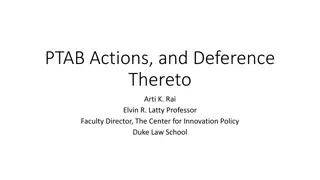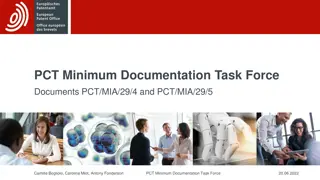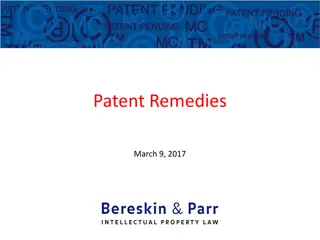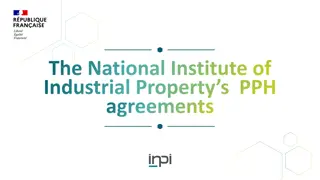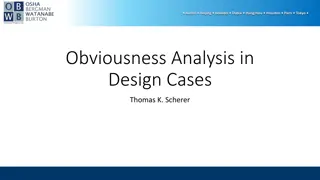Evolution of Patent Eligibility in the USA
Over the years, the landscape of patent eligibility in the USA has evolved significantly, influenced by key Supreme Court decisions and public input. With a focus on life sciences and computer-related technologies, the subject matter for patent protection has undergone changes following SCOTUS rulings. The history of patentability, including the first and second patent statutes, highlights the legal framework governing patents in the US. Various aspects, such as novelty, non-obviousness, and enablement, contribute to determining whether an invention qualifies for a patent.
Download Presentation

Please find below an Image/Link to download the presentation.
The content on the website is provided AS IS for your information and personal use only. It may not be sold, licensed, or shared on other websites without obtaining consent from the author.If you encounter any issues during the download, it is possible that the publisher has removed the file from their server.
You are allowed to download the files provided on this website for personal or commercial use, subject to the condition that they are used lawfully. All files are the property of their respective owners.
The content on the website is provided AS IS for your information and personal use only. It may not be sold, licensed, or shared on other websites without obtaining consent from the author.
E N D
Presentation Transcript
PATENT-ELIGIBLE SUBJECT MATTER: REPORT ON VIEWS AND RECOMMENDATIONS FROM THE PUBLIC
Contents History of patentability in the USA Four key SCOTUS cases Applications of these decisions in circuit courts Public comments
Between 2010 and 2014, SCOTUS issued four decisions (Bilski, Mayo, Myriad, Alice) that shifted the dividing line of eligible and ineligible subject matter. In October 2016, the USPTO issued a notice seeking input on patent-eligibility of subject matter in the wake of the noted SCOTUS decisions. The focus was on two technology areas affected by recent patent law: life sciences and computer-related technologies.
Participants Over 250 participants from across the country representing a broad cross-section of the patent community, including industry, private practice, academia, associations, inventors, and small businesses
Introduction To entitle a patent, a claimed invention must satisfy certain patentability requirements. The subject matter for which a patent is sought must be eligible for patent protection (35 U.S.C. 101) There are additional patentability requirements: novelty, non-obviousness, written description, and enablement
US History of Patentability The first patent statute permitted patenting of any useful art, manufacture, engine, machine, or device, or any improvement therein was the Patent Act of 1790, ch. 7, 1 Stat. 109.
The second patent statute, passed just 3 years later, provided for patent protection for any new and useful art, machine, manufacture or composition of matter, or any new and useful improvement on any art, machine, manufacture or composition of matter (Patent Act of 1793, ch. 11, 1, 1 Stat. 318).
In 1930, Congress enacted the Plant Patent Act to extend patent protection to asexually- reproduced plants. In 1952, Patent Act: Whoever invents or discovers any new and useful process, machine, manufacture, or composition of matter, or any new and useful improvement thereof, may obtain a patent, subject to the conditions and requirements of this title (66 Stat. 797, ch. 10, 101, 1952).
SCOTUS has found mathematical formulas patent-ineligible A scientific truth, or the mathematical expression of it, is not a patentable invention, but a novel and useful structure created with the aid of knowledge of scientific truth may be.
Early SCOTUS Jurisprudence SCOTUS has long recognized limits on patent eligible subject matter beyond explicated set out in the statue. As early as the mid-1800s, SCOTUS stated that [a] principle, in the abstract, is a fundamental truth, which cannot be patented. Nor can an exclusive right be obtained for a new power, such as steam or electricity.
Gottschalk v. Benson, 409 U.S. 63 (1972) The Court held that a method for programming a general purpose computer to convert binary-coded decimal (BCD) signals to pure binary signals is not a process within the statute The Court observed that the claimed process is so abstract and sweeping as to cover both known and unknown uses of the BCD to pure binary conversion. the Court concluded, would wholly pre-empt the mathematical formula and in practical effect would be a patent on the algorithm itself
Diamond v. Diehr, 450 U.S. 175 (1981). Court held that a process for molding synthetic rubber products, using the Arrhenius equation to calculate cure time, is patent eligible subject matter. the claimed process involve[s] the transformation of an article, in this case raw, uncured synthetic rubber, into a different state or thing and comprises a series of steps beginning with the loading of a mold with raw, uncured rubber and ending with the eventual opening of the press at the conclusion of the cure
Four Key SCOTUS Cases Significantly Impacted Patentability Bilski (2010) Mayo (2011) Myriad (2013) Alice (2014)
Bilski Bilski involves a business method for hedging risk. SCOTUS held that the claims at issue were invalid for being directed to the unpatentable abstract idea of hedging risk in the energy market and adding only token post-solution components.
Bilski SCOTUS observed that hedging is a long- prevalent fundamental economic practice, so that allowing the patent claims would pre- empt use of [risk hedging] in all fields and effectively grant a monopoly over an abstract idea. Nevertheless, SCOTUS left open the possibility that some business methods are patent eligible.
Mayo Mayo relates to optimizing drug doses for treating autoimmune diseases in humans. The inventors claim a relation between a blood metabolite concentration after administering a drug and the likelihood of effectiveness or harmful side effects. The patent concerns a method of gauging whether a given dose is too low or too high based on the metabolite level.
Mayo SCOTUS held the claims to be patent-ineligible. This led to a two-step framework for distinguishing patent-ineligible concepts from patent-eligible applications of those concepts.
Mayo First step: consider whether the claims are directed to a judicially recognized exception to patentability, i.e., abstract ideas, laws of nature, or natural phenomena. Second step: consider whether the claims do significantly more than simply describe these natural relations, i.e., whether additional elements considered separately or as an ordered combination transform the nature of the claim into a patent-eligible application
Mayo First step: SCOTUS found the claims directed to a natural law: the relation of a blood metabolite concentration and likelihood that drug dosage would be ineffective or harmful. Second step: SCOTUS found the claims did not do significantly more than describe the relation, i.e., the added elements considered separately and in order did not transform the nature of the claim into a patent-eligible application of the judicial exception.
Myriad At issue: patent-eligibility of claims to isolated DNA (genes) associated with an increased risk of breast cancer, and synthetic DNA created from RNA known as complementary DNA (cDNA). SCOTUS held that the isolated genes fell squarely within the law of the nature exception. Discovering the location of the genes did not render the genes patent-eligible, nor did the act of separating them from their surrounding genetic material.
Myriad While acknowledging that claims to a product with markedly different characteristics from any found in nature may be patent eligible Myriad s claims to isolated genes lacked such characteristics because they do not rely on any chemical changes resulting from isolation, and are not even expressed in terms of chemical composition.
Alice Claims a computer-implemented, electronic escrow service for facilitating financial transactions SCOTUS reaffirmed the Mayo two-step framework and applied it to claims reciting a computer-implemented process, computer system, and computer-readable medium for mitigating settlement risk.
Alice Under step one, SCOTUS concluded the claims were directed to the abstract idea of intermediated settlement. Under step two, SCOTUS considered the claim elements, individually and in combination, do not transform the nature of the claim into a patent-eligible application. SCOTUS concluded that mere computer implementation does not transform an abstract idea into a patent-eligible invention
Federal Circuits Application of the SCOTUS Framework Federal Circuit Courts have applied the SCOTUS framework to a broad spectrum of subject matter and rendered numerous precedent-setting decisions. The cases generally involve life sciences and computer-related technologies.
Life Science Technologies Federal Circuit Courts have found many life science inventions to be patent-ineligible
Ariosa Diagnostics v. Sequenom Claimed invention: method of detecting cell- free fetal DNA (cff DNA) in maternal blood, diagnosing a prenatal condition based thereon and thus avoiding the risks of more invasive techniques.
Ariosa Diagnostics v. Sequenom Federal Circuit Court found claimed methods were patent-ineligible. Methods begin and end with a natural phenomenon, DNA. Each step of method was well-understood, routine, and conventional - even though no one was doing precisely what was claimed.
Enfish v. Microsoft claims a specific improvement to the way computers operate, embodied in the claimed "self-referential table" for a database, which the relevant prior art did not contain.
Enfish v. Microsoft Under first step of Alice, Federal Circuit Court found claimed data storage and retrieval system for computer memory are not directed to an abstract idea but to a specific improvement to the way computers operate, embodied in the self-referential table. Because the claims were not directed to an abstract idea under step one, the court did not proceed to step two of the analysis and concluded the claims were patent-eligible.
Bascom Global v. AT&T Mobility Claimed system for filtering Internet content. Under step one of Alice, Court found claims to be directed to an abstract idea. Filtering content is . . . a longstanding, well- known method of organizing human behavior, similar to concepts previously found to be abstract. Unlike Enfish, Court went to step two of Alice.
Bascom Global v. AT&T Mobility Court found the ordered combination of limitations to recite more than an abstract idea, the installation of a filtering tool at a specific location, remote from the end-users, with customizable filtering features... The claims do not preempt all ways of filtering content on the Internet but recite a specific, discrete implementation of the abstract idea of filtering content. Conclusion: claims pass step two of Alice
McRO v. Bandai Namco Games Federal Circuit Court found that a method for automated animation of lip synchronization and facial expression of 3-D characters was patent-eligible subject matter. Court concluded that claimed invention was not drawn to an abstract idea, because [w]hether at step one or step two of the Alice test . . . a court must look to the claims as an ordered combination, without ignoring the requirements of the individual steps.
Amdocs (Israel) v. Openet Telecom Court determined that computer readable medium and method for collecting and processing network accounting records over a network is patent-eligible. The claimed invention is directed to an ineligible abstract idea under step one, but it is eligible under step two because it contains a sufficient inventive concept by requiring computer code to enhance an accounting record.
Public Views of Patent-Eligibility Commentators generally agreed that Bilski, Mayo, Myriad and Alice have had a significant impact on the scope of patent-eligibility. Commentators generally disagreed on whether the impact was positive or negative.
Positives SCOTUS two-part eligibility test leads to sound outcomes when properly employed. Case law developed in Federal Circuit Courts since Alice is sensible approach to weeding out vague, low-quality patents. Alice corrects sense of patent-eligibility and avoids unduly broad claims, e.g., in software and electronic commerce.
Positives Supreme Court decision emphasized a distinction between claiming only results, which should not be patent eligible. A specific way of achieving a result maybe patent eligible. A patent should be awarded only for the particular way invented. The public should have the right to achieve the same utility and result in a different way.
Positives Claims that solve a problem with an abstract idea could preempt particular solutions that the inventors may never have contemplated. The abstract idea exception is useful for policing patentability and preventing preemption. Alice could create incentives for applicants to improve both the disclosure in their specifications and the specificity of the claims.
Positives Litigation tool against patent assertion entities, which acquire patents for the purpose of aggressive enforcement and often employ abusive litigation practices. Means of having a suit dismissed at the pleading stage rather than litigating.
Positives A patent ineligibility tool could be especially useful defense for small companies, because over 80 percent of patent assertion entity activity targets small- and medium-sized businesses, and over 50 percent of patent assertion entity suits are filed against startups.
Positives R&D spending on software and the internet was over 16% in the 12 months prior to Alice but rose to over 27% in the 12 months after Alice. No decline in innovation in the wake of Alice.
Positives The new SCOTUS eligibility standard differs from standards abroad, but some commentators project that this could benefit the USA. If a company is innovating because it can get patents in Europe but not as much protection in the USA, what is important is that the company is still innovating.
Positives If US consumers can benefit from the additional competition that will result from a lack of patent protection and thus pay lower prices, and the innovator can still recover investment by way of monopoly profits elsewhere, that is potentially a net positive.
Negatives The legal foundation of the SCOTUS decisions on patent eligibility seem debatable. SCOTUS failed to appreciate the statutory history of the term discover , including the legislative history of the 1836 Act, which expressly states that the purpose of the patent system is to reveal the mysteries of nature, and the Plant Patent Act, which permits patents on discoveries.
Negatives [M]any in the patent profession...have come to the conclusion that there is no constitutional or policy justification for the Mayo/Alice test and that the Supreme Court s holdings in at least some cases are arguably unconstitutional.
Negatives Others assert that the Court has imposed improper limitations on the full scope of Congressional authority under the Constitution to promote progress in science and the useful arts Accused the Court of having invented extra- statutory eligibility criteria.
Negatives Contends that abstract idea has become in effect a euphemism for broad claims, which is not fair to those that saw a void in the marketplace and created a product to fill that void. Complains of the impact of Alice on business and financial-related inventions, arguing that the decision devalued entire patent portfolios.
Life Science Industry Views of Patent-Eligibility The law of nature and natural phenomena exceptions are overly broad. Most biopharmaceutical innovation relates to laws of nature and natural phenomena in some way.
Life Science Industry Views of Patent-Eligibility Inventive preparations based on naturally- occurring substances have historically been of great importance in biotechnology. After large investments made over decades, thousands of existing patents have come under a cloud of unpatentability and invalidity.
Two-Step Test Lacks Clarity and Increases Unpredictability Two-step test is highly subjective, impractical, and unpredictable in the issuance and enforcement of patents. [It] is impossible to define abstract idea with sufficient certainty to serve as a legal standard for anything, let alone the important determination of whether an invention is patent eligible.
Preemption Conflates 101 and Other Patentability Provisions SCOTUS has conflated eligibility with the more rigorous patentability requirements set forth in 35 U.S.C. 102 and 103. Importing considerations of novelty and non- obviousness into the eligibility analysis creates systemic problems because eligibility becomes a blunt instrument for denying patent rights.
